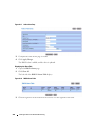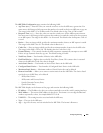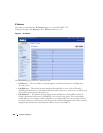
452 Configuring Routing
ARP
The
PowerConnect M6220/M6348/M8024
uses the ARP protocol to associate a layer 2 MAC address with
a layer 3 IPv4 address. Additionally, the administrator can statically add entries into the ARP table.
ARP is a necessary part of the internet protocol (IP) and is used to translate an IP address to a media
(MAC) address, defined by a local area network (LAN) such as Ethernet. A station needing to send an IP
packet must learn the MAC address of the IP destination, or of the next hop router, if the destination is
not on the same subnet. This is achieved by broadcasting an ARP request packet, to which the intended
recipient responds by unicasting an ARP reply containing its MAC address. Once learned, the MAC
address is used in the destination address field of the layer 2 header prepended to the IP packet.
The ARP cache is a table maintained locally in each station on a network. There are no specific
requirements for the construction or maintenance of this cache, but at a minimum it needs to contain
the information learned from processing ARP protocol packets, which for Ethernet are denoted by an
0x0806 EtherType field. ARP cache entries are learned by examining the source information in the ARP
packet payload fields, regardless of whether it is an ARP request or response. Thus, when an ARP request
is broadcast to all stations on a LAN segment or virtual LAN (VLAN), every recipient has the opportunity
to store the sender’s IP and MAC address in their respective ARP cache. The ARP response, being
unicast, is normally seen only by the requestor, who stores the sender information in its ARP cache.
Newer information always replaces existing content in the ARP cache.
The ARP cache can support 896 entries, although this size is user-configurable to any value between 256
and 896. When multiple network interfaces are supported by a device, as is typical of a router, either a
single ARP cache is used for all interfaces, or a separate cache is maintained per interface. While the
latter approach is useful when network addressing is not unique per interface, this is not the case for
Ethernet MAC address assignment so a single ARP cache is employed.
Devices can be moved in a network, which means the IP address that was at one time associated with a
certain MAC address is now found using a different MAC, or may have disappeared from the network
altogether (i.e., it has been reconfigured, disconnected, or powered off). This leads to stale information
in the ARP cache unless entries are updated in reaction to new information seen on the network,
periodically refreshed to determine if an address still exists, or removed from the cache if the entry has
not been identified as a sender of an ARP packet during the course of an ageout interval, usually
specified through configuration.
The ARP menu page contains links to web pages that configure and display ARP detail. To display this
page, click Routing > ARP in the tree view. Following are the web pages accessible from this menu page:
•ARP Create
• ARP Table Configuration


















